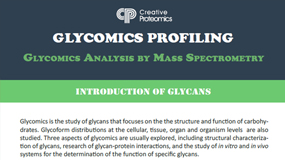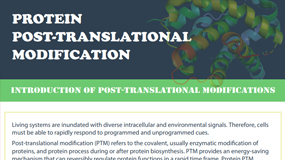Glycosylation is the one of the most challenging post-translational modifications. It usually has a set of modifications instead of a single modification. Even a single glycosylated site on a peptide possesses multiple glycan isoforms with different chain length and branches attached. O-glycans link to a polypeptide mainly through a glycosidic bond between the terminal monosaccharide residue and the OH group of Serine or Threonine. Unlike N-glycans, O-linked amino acid consensus sequence is yet unkown. The O-glycans are structurally diverse and can be divided into several structural families with relatively heterogeneous core structures.
 Figure 1. Different core structures of N-linked glycans
Figure 1. Different core structures of N-linked glycans
It is sofar no universal enzyme to digest the majority of O-linked glycans, unlike N-glycans. O-glycanase only removes unsubstituted disaccharide O-GalNAc initiated glycans. Chemical release is mainly the method for O-glycan separation. Majority of O-glycans are released from O-glycopeptides namely β-elimination.
 Figure 2. The general procedure of sample preparation for Glycan profiling
Figure 2. The general procedure of sample preparation for Glycan profiling
O-glycans profiling is usually performed using MALDI-TOF MS. It is necessary to derivatize O-glycan by permethylation to transform all hydroxyl groups into methyl ethers and stabilizes sialic acids by methyl esterification of their carboxyl groups. This allows MALDI TOF MS to analyze of all O-glycans in the positive mode. Direct infusion of O-glycans of permethylation into the mass spectrometer can provide information about glycans composition.
 Figure 3. Example of O-Glycan structures detected and analyzed by using MS1
Figure 3. Example of O-Glycan structures detected and analyzed by using MS1
More than 60% of therapeutic proteins are post-translationally modified following biosynthesis by the addition of N-glycans or O-glycans. It is necessary to characterize glycans in efficient manufacturing processes so as to maintain continued biotherapeutics glycosylation patterns. At Creative Proteomics, we provide o-glycan profiling service to support the development and commercialization of therapeutic proteins. The workflow of our O-glycan profiling analysis is as follows.
 Figure 4. Workflow for O-glycan profiling service.
Figure 4. Workflow for O-glycan profiling service.
- Release. O-linked glycans are commonly released through reductive alkaline β-elimination.
- Isolation. Released O-glycans can be enriched by hydrophilic interaction chromatography (HILIC). The linkage of each glycan form can be confirmed by the digestion with specific exoglycosidases.
- Labeling. To improve high-performance liquid chromatography (HPLC)- and MS-based glycan analysis, released glycan are fluorescently labeled with 2-aminobenzoic acid (2-AA) or 2-aminobenzamide (2-AB).
- Enrichment. Labeled o-glycans are enriched by IHLIC.
- Detection. Enriched o-glycans are then detected by MALDI-TOF MS (matrix-assisted laser desorption/ionization-time of flight mass spectrometry) or ESI-MS (electrospray ionization mass spectrometer).
Sample Requirement
We work with a range of sample sources as follows.
- Protein: 100 ug
- Cells: 1×107
- Animal tissues:1 g
- Plant tissues: 200 mg
- Anticoagulated blood (EDTA): 1 mL
- Serum: 0.2-0.5 mL
- Urine: 2 mL
- Microbial sample: 200 mg (dry weight)
Advantages of O-Glycan Profiling Service
- High-sensitivity, reproducible O-glycan patterns
- A relatively fast turnaround time
- High coverage of O-glycans
- Work with complex biological matrices, like cells and tissues
- Detailed reports including experimental procedures, parameters of liquid chromatography and mass spectrometer, MS raw data files, O-glycan profiling results, and bioinformatics analysis.
As one of the leading companies in the proteomics field with decades of experience, Creative Proteomics provides glycomics analysis service customized to your needs. Please contact us to discuss your project.
How to place an order

*If your organization requires signing of a confidentiality agreement, please contact us by email.
Reference
- S. Yang, Y. Hu, L. Sokoll & H. Zhang (2017). Simultaneous quantification of N- and O-glycans using a solid-phase method, Nature Protocols, 12, 1229–1244.




















